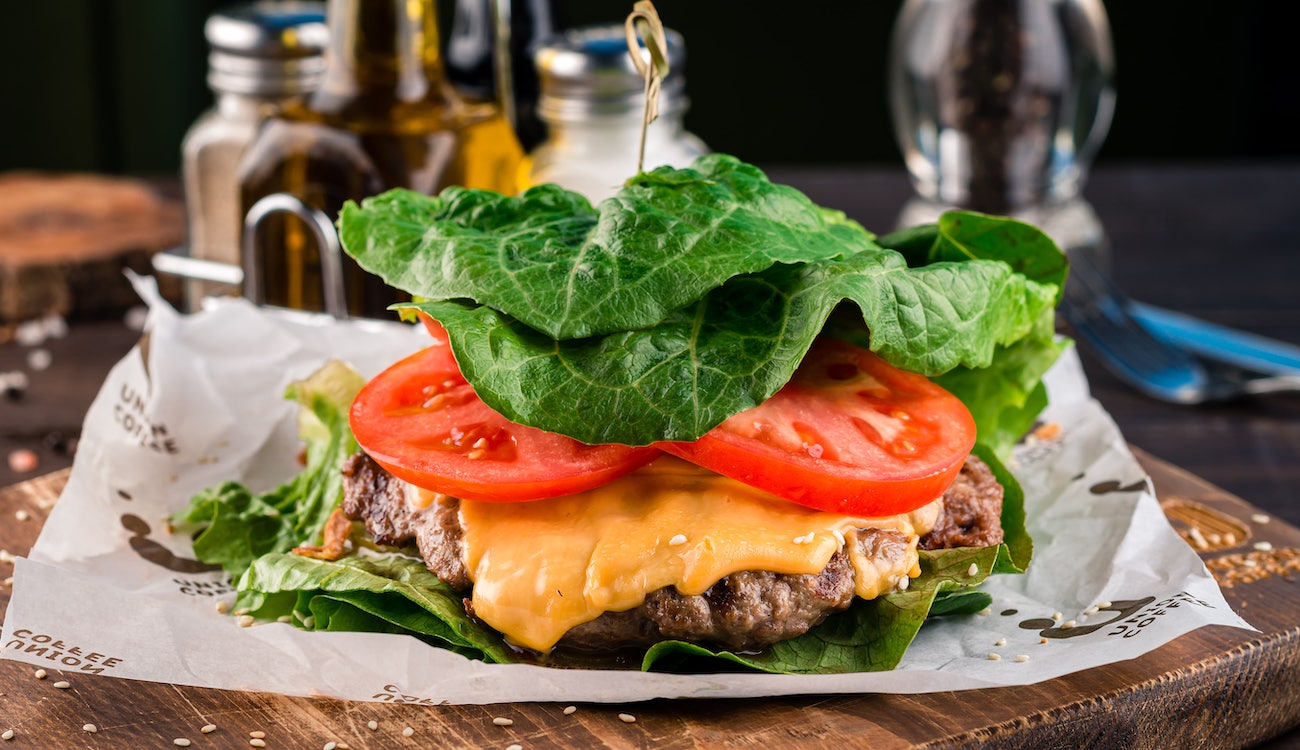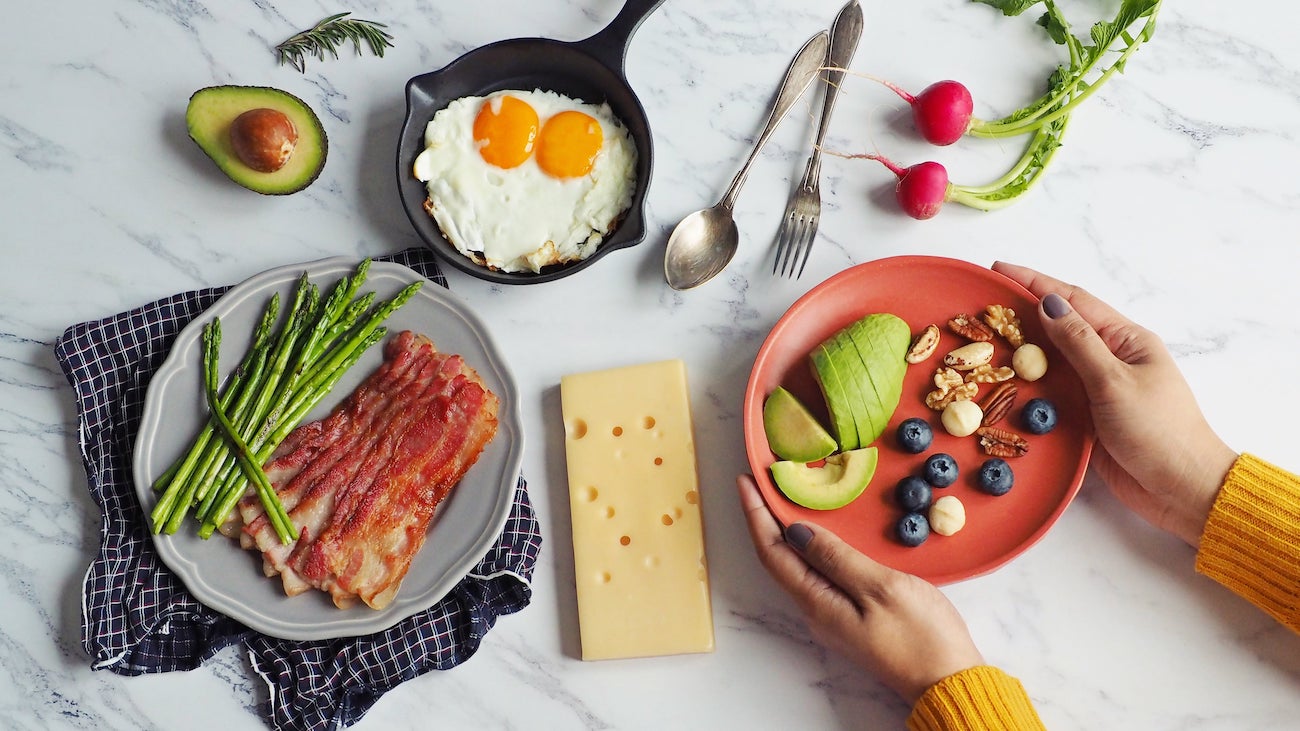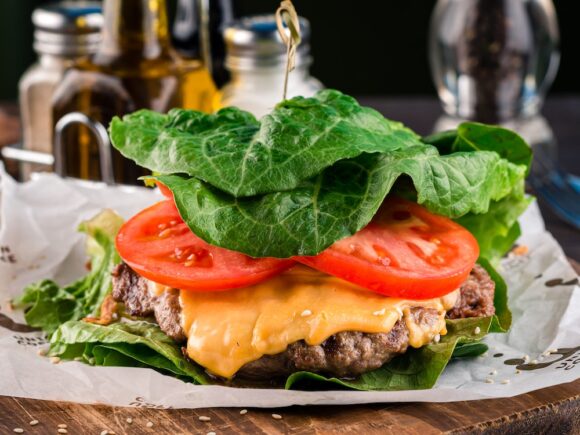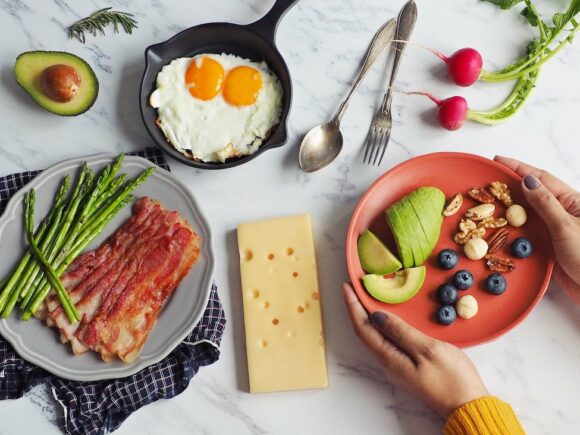Plant-Based Keto Meal Plan: Benefits, Foods, and Recipe Ideas


The ketogenic diet is one of the most popular weight loss diets. It follows a low-carb, moderate-protein, and high-fat diet. Most people rely on animal products to achieve protein requirements, especially because plant-based proteins are usually high in carbs.
But, there is a way to get all the health benefits from a ketogenic diet and a plant-based approach.
Here, we’ll go over everything you need to start a plant-based keto meal plan and a delicious 7-day meal plan to set you right for the week.
What Is a Plant-Based Keto?
A plant-based keto diet is a low-carb, moderate-protein, and high-fat diet. This typically means consuming 5–10% of carbs, 20% protein, and 70–80% fat.
Since carbs are reduced to 20–50g per day, the body doesn’t have enough glucose to serve as an energy source. As a result, the body metabolically adapts to create ketones as the new energy source.
Generally speaking, a plant-based ketogenic diet is similar to a traditional one. It simply removes some animal protein sources.
For example, instead of having chicken, fish, seafood, or meat, you only eat eggs and dairy as the only animal products.
A ketogenic diet has several benefits, such as weight loss and improved blood work. However, when you mix it with a plant-based approach, it boosts the health benefits even more. Focusing on plant-based options can help reduce inflammation and improve heart health.
Keep in mind that a plant-based keto meal plan is completely different from a vegan ketogenic diet. Vegan diets remove all animal products. So, when you follow a vegan diet, not only do you remove dairy and eggs, but also gelatin, some collagen supplements, and honey.
If you want to follow a vegan keto meal plan, you need to remove all products from animal sources.
But that is not the case for your plant-based ketogenic diet. Here, in this keto diet plan, you’ll find meals with eggs and dairy products.
The Benefits of a Plant-Based Keto Diet
Currently, there is not a lot of research about following a plant-based keto diet. However, there is some evidence to determine the health benefits of following each approach separately.
Keep in mind that the following benefits can also be applied to vegan keto diets.
The biggest benefit of following a plant-based keto diet is weight loss. A study compared the effects of a plant-based ketogenic diet against a high-carb diet. The results showed those who followed a plant-based ketogenic diet lost 2lbs more than those who followed a high-carb plant-based approach.
Another benefit of following a plant-based approach is its effect on heart health. Evidence suggests that people who follow a plant-based diet reduce the risk of heart disease by 32%. This is due to its effect on lowering cholesterol, triglycerides, and blood pressure.
Like a plant-based approach, a ketogenic diet can positively affect cholesterol levels and triglycerides.
Following a plant-based or ketogenic diet can also benefit your blood sugar levels. Research shows that following a plant-based diet or a keto diet can help produce better blood sugar control, reducing the risk of diabetes.
Finally, one of the benefits that makes a ketogenic plant-based diet stand out over a traditional keto diet is its fiber consumption. As we are going to see later in the article, one of the risks of following a keto approach is constipation. However, on a plant-based keto diet, you consume a high amount of vegetables, and since plant sources are high in fiber, they can significantly decrease the risk of any digestive problems.
How to Follow a Plant-Based Keto Diet
Starting a low-carb plant-based diet meal plan might sound overwhelming. However, you can start by having one day a week where you try a plant-based approach or even trying a vegan diet.
So, instead of having chicken, meat, seafood, and fish, opt for other options like eggs, dairy, and soy products. Once you make it a routine to switch to one meal a day following a plant-based approach, you can try having 2 meals a day.
Do this until you manage to go every single day without any chicken, fish, seafood, or meat. Even better if you can have a few low-carb vegan diets throughout the week.
Finally, plan the meals you will have to set yourself up for success. This allows you to stay on track and avoid adding food items not included in your diet plan.
In the end, the more you stick to the meal plan, the better your outcome will be.
What Not to Eat on a Plant-Based Keto Diet?
All keto diets limit high-carb foods like whole grains, starchy vegetables, legumes, and sugary foods. Since these foods are very high in carbs, they can affect ketosis.
Also, when following a plant-based approach, most animal products are eliminated. While you still can eat some animal products, you eat them in small amounts and only from a few sources.
Here is a list of the foods you must consume in moderation or limit because of their high-carb content:
- Grains: oats, quinoa, rice, pasta, barley, buckwheat, and rye.
- Starchy vegetables: potatoes, beets, yams, cassava, parsnips, and sweet potato.
- Legumes: beans, peas, lentils, and chickpeas.
- Fruits: apples, peaches, bananas, melons, plums, and berries.
There are other high-carb foods we recommend completely avoiding since they can increase glucose levels and make it easier to affect ketosis:
- Sweeteners: brown sugar, table sugar, honey, maple syrup, and agave.
- Processed foods: bread, cookies, pastries, granola, breakfast cereal, soft drinks, and baked goods.
If you want any of the options above, look for those recommended for a keto diet. For example, instead of having a regular cookie opt for a keto-friendly cookie.
As for the protein options, these are the ones to eliminate:
- Meat: ground beef, pork, beef, veal, and venison.
- Poultry: turkey, chicken, goose, and duck.
- Fish and seafood: salmon, tuna, sardines, crab, oysters, shrimp, and lobster.
What Can You Eat on a Plant-Based Keto Diet?
Moving along in this plant-based keto food list, let’s talk about the foods you can add to your keto plant-based meals.
Since you limit carbs, the best option to replace them is non-starchy vegetables. While they are also a source of carbs, they are low in calories and high in fiber, making them low in net carbs.
Vegetables help increase your nutrient intake, simultaneously reducing the risk of nutrient deficiency, and are also a good source of fiber, promoting good digestion.
Remember to have some variety in your vegetable intake. Every color provides a different benefit and nutrient, so the more colors you add, the more nutrients you get.
Healthy fats are going to be the main source of energy in the body. A common mistake is not tracking how many grams of fat you eat per day. Not only can this affect the results, but it can also affect energy levels.
As for proteins, they are essential because they increase satiety, support muscle mass, and slightly increase metabolism. Try to have a protein source in every meal to make it easier to reach daily requirements.
Here is a list of food items you can include in your favorite plant-based keto meals:
- Non-starchy vegetables: leafy greens, mushrooms, onions, celery, tomatoes, zucchini, cauliflower, and broccoli.
- Healthy fats: olive oil, coconut oil, avocado oil, flaxseed oil, and MCT oil.
- Nuts: pecans, peanuts, cashews, almonds, and nut butter.
- Seeds: flax seeds, chia seeds, hemp seeds, and pumpkin seeds.
- Protein: eggs, cheese, spirulina, Greek yogurt, and tempeh.
- Milk alternatives: coconut milk and almond milk.
7-Day Plant-Based Keto Meal Plan Recipe Ideas
Now that you know which foods to add and which to avoid, it’s time to start making some meals.
Planning meals can make it easier to follow the meal plan. Writing down the food you are going to have for the week, and meal prepping, can not only save you time, but it can also save you money.
We know it might sound scary to start this new journey. However, we’ve created a 7-day meal plan with 21 delicious plant-based keto meals to help you get started.
Monday
Breakfast: Strawberry and Peanut Butter Smoothie
If you want to start the day on the right foot by giving the body all the essential amino acids it needs, this strawberry and peanut butter smoothie is the best option. It only takes 5 minutes to prepare and provides you with more than 20g of protein.
Lunch: Radish, Walnut, and Feta Cheese Salad
A quick lunch doesn’t have to be complicated. A refreshing salad perfect for the summer is just what you need. Toss all the ingredients in a bowl, and you have a high-protein lunch in less than 5 minutes. You can even make it in advance, as long as you don’t put on the dressing.
Dinner: Fried Tofu With Almonds
For those new to a plant-based approach, trying tofu might be frightening. But this simple and tasty fried tofu with almonds will make you want to have tofu every day. For a twist to the recipe, try adding some avocado to the cucumbers on the side. It is a great way to boost your fat intake.
Tuesday
Breakfast: Greek Yogurt With Berries and Chia
The following day, you must rush out of the house. To avoid having a meal on the way to work and avoid risking your ketosis levels, try making this Greek yogurt with berries and chia the night before. Not only will it help you stay on the right path, but it’s even tastier than a fast food breakfast.
Lunch: Poached Egg, Cauliflower, and Avocado Bowl
For egg lovers, there is nothing better than having a poached egg for lunch. The texture of the poached egg pairs nicely with the crunchiness of the cauliflower. On top of that, the creaminess of the avocado combines everything into the perfect dish.
Dinner: Zoodles With Spinach and Parmesan
You won’t be missing a regular pasta bowl when you try this recipe. The parmesan in this recipe makes this zoodle dish one of the creamiest treats you will ever try. On top of that, basil adds some freshness to help balance the dish.
Wednesday
Breakfast: Cherry Tomato Omelet With Arugula Salad
Switch up the boring scrambled eggs for this cherry tomato omelet with arugula salad. Additionally, adding the arugula salad on the side is an excellent way to boost your vegetable intake while getting your daily dose of high-quality protein. We can assure you there is no better breakfast option than this.
Lunch: Tofu and Broccoli Stir-Fry
The saltiness of the tamari, the spiciness of the paprika, and the creaminess of the tofu are what make this dish a best-seller. For those who want to experiment with adding more flavor, try adding some ginger to help digestion and spice things up even more.
Dinner: Roasted Parmesan Cauliflower With Yogurt Sauce
Greek yogurt can be a great way to add some creaminess to your favorite dish while boosting its protein content. The roasted cauliflower’s smokiness and the perfect blend of parmesan and yogurt make this guilt-free dish ideal to add to a low-carb plant-based diet.
Thursday
Breakfast: Peanut Butter and Strawberries Pancakes
Pancakes for breakfast? And still lose weight? Yes, please! These high-protein and high-fiber pancakes will leave you feeling satiated for a long time. So, say goodbye to feeling peckish in the morning or reaching lunch starving. Make sure you accompany it with a low-carb syrup.
Lunch: Cucumber, Bell Pepper, and Parmesan Salad
Salad doesn’t have to be only lettuce with a couple of tomatoes. Say goodbye to a boring salad with these ingredients that give you a punch of flavor while still providing you with all the nutrients and protein you need. As a tip, you can switch the parmesan with feta cheese or have a bit of both.
Dinner: Zucchini Fries With Greek Yogurt Dip
If you are missing french fries, you won’t be missing anymore with these zucchini fries with Greek yogurt dip. It makes an ideal dinner for those who don’t like to have a very heavy meal. Add some green salad on the side if you want to have a filling meal.
Friday
Breakfast: Berry Peanut Butter Smoothie
Berries are high in antioxidants, which can help reduce inflammation. To start your day feeling refreshed with low levels of inflammation, this berry peanut butter smoothie is the best breakfast for those needing an energy boost first thing in the morning without affecting ketosis.
Lunch: Fried Tofu and Avocado Salad
The different textures make this one of the best salads you’ll ever try. The crispiness of the fried tofu with the creaminess of the avocado salad will make everyone jealous of the tasty treat you are having. Add a bit of sesame oil to add an extra punch of flavor.
Dinner: Cauliflower Rice With Eggs and Spinach
It’s Friday night, and you want takeout, especially Chinese takeout. But, most dishes are not keto-friendly. This cauliflower rice with eggs and spinach is a healthier alternative to Chinese takeout. And we dare say it is even more delicious than takeout! Add some tamari and ginger for an extra flavor boost.
Saturday
Breakfast: Egg With Avocado and Bell Pepper
Fried eggs for breakfast? Count me in! We can assure you that after you have our take on fried eggs, you’ll never want another version ever again. Add some tomato sauce with the fried eggs for those wanting an extra kick of flavor.
Lunch: Fried Tofu, Spinach, Bell Pepper Salad
Tomato cherries, bell peppers, basil, and paprika. I know what you are thinking: it can get better than this. But what if you add some fried tofu on top? Instead of having croutons, which are simply going to throw your ketosis off, tofu helps you reach your protein intake and still get that crunchy texture.
Dinner: Zoodles With Parmesan and Pumpkin Seeds
Comfort food doesn’t only have to be for those following a high-carb diet. You can also have comfort food in a low-carb option. A nice bowl of zoodles with parmesan and pumpkin seeds is the best meal whenever you want to stay in and watch a movie with a delicious recipe.
Sunday
Breakfast: Greek Yogurt With Seeds and Berries
You woke up late. And, let’s be real – it’s a Sunday morning, and the last thing you want to do is spend more time in the kitchen. Try this Greek yogurt with seeds and berries recipe for a quick meal that will only take 5 minutes to prepare.
Lunch: Stir-Fried Cauliflower With Egg
Whether you opt for frozen or fresh cauliflower, this healthier alternative to cauliflower rice is the best way to keep you on track when following a plant-based ketogenic diet. To add more nutrients and a splash of color, you can add some celery and carrots.
Dinner: Feta Salad With Walnuts
For a simple and easy-to-make Sunday night dinner, this feta salad with walnuts is the best way to end a perfect week. The walnuts’ crunchiness, the feta cheese’s creaminess, and the basil’s freshness make this a one-of-a-kind salad.
Plant-Based Keto Snacks
If you want to include a ketogenic snack, here are some options. Remember, the number of snacks depends on the number of calories you need per day based on your goals:
- Almonds with cheese sticks
- Berries with coconut milk yogurt
- Cucumber stuffed with cream cheese
- Keto bars
- Guacamole with zucchini chips
- Celery sticks with almond butter
- Hard-boiled eggs with walnuts
- Protein smoothie with full-fat coconut milk
Can the Plant-Based Keto Diet Help With Weight Loss?
Yes, a plant-based diet can aid in weight loss. But you need to be in a caloric deficit, meaning you need to eat fewer calories than the body needs. This makes the body go into fat reserves, making you lose weight.
Not only does research determine that those following a vegan diet have a more significant weight loss. But evidence suggests that people who follow a plant-based diet are less likely to regain the weight.
As for the ketogenic diet, one of the main benefits of the diet is its initial rapid weight loss. Studies show that people might lose 10lbs in less than 2 weeks.
With that said, keep in mind that this is not always the case, and usually, the rapid weight loss is due to water and muscle loss. Still, a plant-based ketogenic diet might be ideal for losing weight and increasing overall health.
Plant-Based Keto Diet Side Effects
As we’ve seen, the keto diet has several health benefits. However, there are also some side effects you need to keep in mind.
Carbs are the main source of fiber. So, when you significantly reduce them, you might experience constipation. This can make you uncomfortable, especially if it’s been a couple of days since you’ve gone to the bathroom.
To avoid this, make sure to have a good intake of non-starchy vegetables, increase water intake, and add some lemon to the water.
Another common side effect is bad breath, especially during the early stages.
When the body starts producing ketones, it creates acetone as a by-product. Acetone has a very pungent smell, which is why you might notice a change of breath.
In addition, if you are not careful with the type of fats you include, it can increase the risk of heart disease. Instead of adding too much animal fats, like butter and sour cream, opt for olive oil, avocado oil, and flaxseed oil.
Remember that while coconut oil is a healthier fat, it is still high in saturated fats, so you need to consume it in moderation.
Finally, the last two side effects of a plant-based keto diet are an increase in nutrient deficiencies and getting the keto flu.
Let’s talk about each one.
Nutritional deficiencies
If you don’t have a plan and are not careful about your meals, you might increase the risk of nutrient deficiency.
A plant-based approach might increase the risk of nutrient deficiencies such as vitamin B12, vitamin D, zinc, calcium, iron, and omega-3 fatty acids. All of which are important to keep the body healthy.
However, you can easily prevent this if you include nutrient dense-foods:
- Vitamin B12: spirulina, eggs, nutritional yeast, and tempeh.
- Vitamin D: egg yolk and fortified foods.
- Zinc: tempeh, nuts, and seeds.
- Calcium: dairy products, sesame seeds, and leafy greens.
- Iron: eggs, leafy greens, nuts, and seeds.
- Omega-3: flax seeds, chia seeds, and hemp seeds.
The keto-flu
Finally, the last side effect you might notice in the beginning is the keto flu.
When the body switches from glucose to ketones as a main energy source, it might increase side effects like nausea, headache, foggy brain, and fatigue. This group of symptoms is what is commonly known as the keto flu.
To avoid this, drink plenty of water and add some sugar-free electrolytes.
Conclusion
A keto plant-based diet is ideal for those who want to lose weight but still have a low animal protein intake. In this low-carb approach, most of the protein you get from eggs, dairy products, and other plant-based protein sources like nuts, seeds, and tofu.
Ensure you include a good portion of non-starchy vegetables to get as many nutrients as possible and avoid any nutrient deficiencies. Also, include foods high in vitamin B12, iron, zinc, calcium, and vitamin D to have a balanced diet. Finally, protein requirements can be tough to reach. Include a protein source in every meal to make it easier to have the desired protein amount.
To have an easier beginning with the keto diet, download the Keto Cycle app. It’s an all-in-one data tracker to have everything you need in one place. It also provides you with a meal plan, a shopping list, and even workouts you can do to reach your goals.




























